Category Archive for Food + Theme Restaurants
A Gothic Halloween in London, UK! Viktor Wynd cabinet of curiosities, absinthe bar, horror-themed afternoon tea.

Happy Nightmare before Christmas!
I’m not much of an X-mas person…. so in the spirit of Jack Skellington, this post is going to be about how to celebrate Halloween in London, United Kingdom!
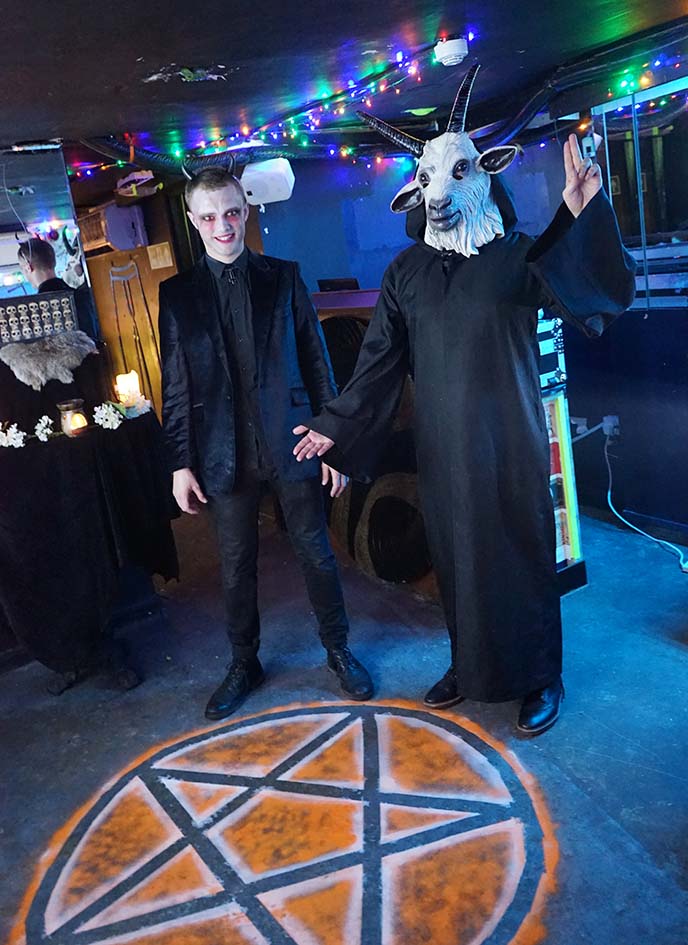
Ye ol England was one of the original centers of Goth subculture, and remains one of the best cities for Gothic, bizarre and underground festivities. I spent Halloween 2017 with my friends in London, and it turned out to be one of the best All Hallows Eves yet.
Our dark bacchanal included the Black Devil Disco Club (above), seeing The Exorcist stage play, enjoying monster-movie themed afternoon tea, and drinking absinthe at a cabinet of oddities. Keep reading for details of these London Halloween bars, events and parties!

But first, a peek at my Nightmare Before Xmas outfit. You won’t catch me wearing red and green this season. Instead, I like to layer faux fur during the winter, and break out my Sorel knee-high boots. (Click below to see where I got these items.)

Tis the season… for unique stockings and socks! My go-to source is always UK Tights — they ship worldwide, and have the largest online selection of legwear, including fishnets, patterned and luxury hosiery.

Since it’s now too cold to go barelegged, I’ve been reaching for above-the-knee or thigh-high socks. I love the alternative look of these Girardi Meredith hold-ups, especially when paired with a short black skirt and sweater. The faux leather cuff at the top stays securely, and is decorated with an adorable bow.
You can find these socks and other fashion legwear from my friends UK Tights. I’ll be wearing these and more all winter.
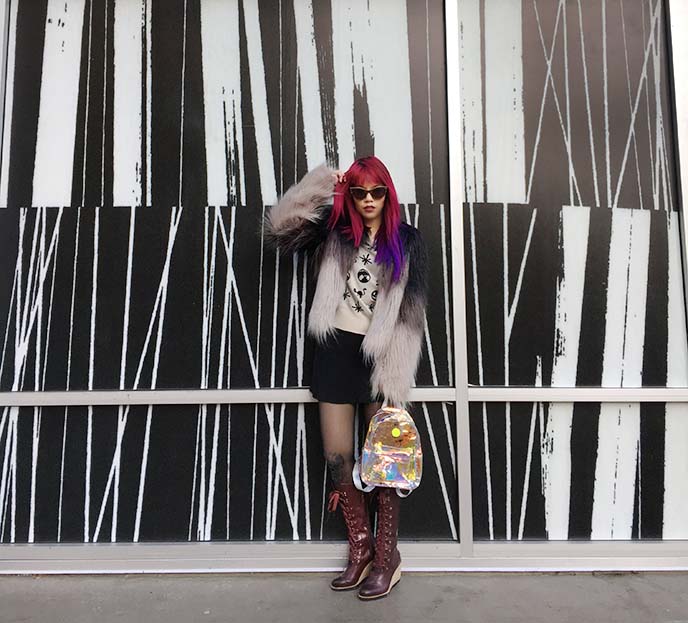
– Here’s a different spin on this look. I’m accessorizing with a holographic Cyberdog backpack, and Moat House wood sunglasses.
– My faux fur jacket is from Pretty Attitude, similar to this furry and this ombre jacket.
– I’m wearing these exact Sorel boots (the After Hours no tongue lace-up boots in redwood leather). For more info, click below.
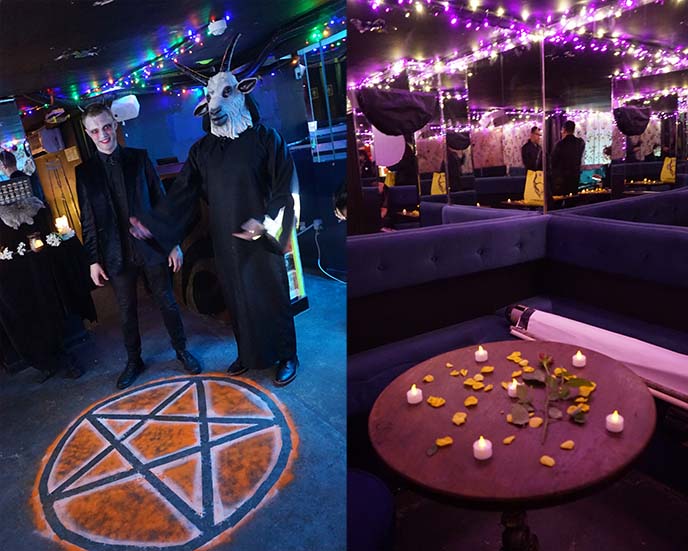
Now, let’s descend into the London Underworld. When you see Baphomet and a pentagram… you know you’ve entered the den of the British Satanists!
This pre-Halloween event was the first edition of their “Black Devil Disco Club,” which brings together two of my favorite things (the devil and disco).
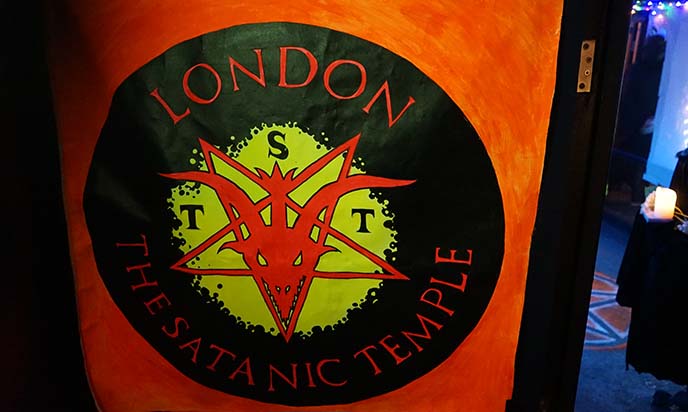
The members are atheist, and advocate for fact-based science, and marginalized communities. Everyone I met at the event was kind and inclusive.
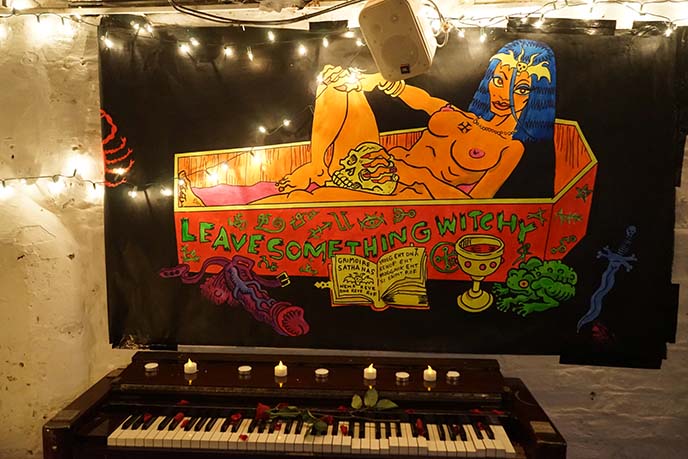
At the Black Devil Disco night, the DJs played tracks by Patrick Cowley, Giorgio Moroder and other Italo Disco heroes. Between boogieing, you could get a tarot reading or “leave something witchy” in the candlelit back room.

I wanted to do some “only in London” excursions, such as seeing a play in the West End. I’m not a fan of cheesy musicals, so I didn’t come across anything appealing… until I learned The Exorcist was opening at the Phoenix Theatre!
I reunited with my friend Vanessa, and we went to one of the first showings of The Exorcist. I was keen to see how they’d adapt William Peter Blatty’s horror novel and 1970s movie, for a live stage production.

We weren’t allowed to shoot photos during the performance, so I’m doing my best impression of Regan, the little girl possessed by a demon (voiced by Sir Ian McKellen.) The cast nailed their parts, especially during the battle against the evil spirit Pazuzu.
The Exorcist’s lighting and set were outstanding, especially the spooky candlelight confessions and blood writings on the wall. There were jump-scares, and fantastic effects — let’s just say, they’re literally hair-raising and head-turning.
If you’re in London and a horror fan, The Exorcist is the play for you. Tickets and info here — this is a limited run show, which ends on March 10, 2018.

What else is a rather British activity? Afternoon tea.
There are many London venues for tea and finger sandwiches. However, when I read that Royal Lancaster Hotel was offering a Halloween afternoon tea, I knew I’d found my place. (Address: Lancaster Terrace, London W2 2TY, UK)
I entered the recently-renovated modern hotel, and was delighted to see that the tearoom was decorated in the theme of 1960s horror movies! Royal Lancaster nailed the classy details: everything is in black and white, with celluloid-printed menus and a clapboard that read 666.

Out came a black-and-white themed tray, with a fog of dry ice! Royal Lancaster’s ArTea set included a mix of creatively-designed, delicious savories and sweets.
My favorites included the cucumber and pumpernickel sandwiches, sushi with black caviar, a scotch egg with black crust, and popcorn in a coffin (a nod to the film theme). The macaroons and checkered cake went perfectly with our pots of tea: we ordered a selection, including classic Earl Grey, and a ginger medley.

Royal Lancaster chose a 1960s classic horror theme since this year is the hotel’s 50th birthday. The tearoom set the mood with black-and-white footage from Hitchcock’s Psycho.
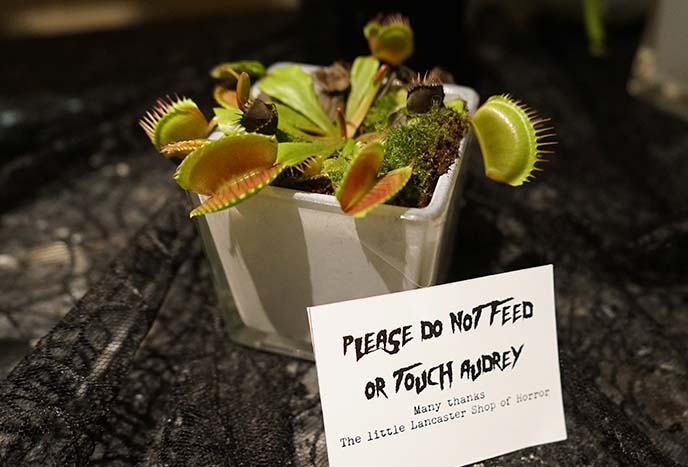
I loved the imaginative, classy take on the theme (this doesn’t feel like a kid’s kitschy Halloween experience). All around the room, there were carnivorous plants in homage to Audrey, the Venus fly trap from Little Shop of Horrors.

We ended our monochrome meal with freshly-backed black scones, with clotted cream, marmalade, and cake pops. Royal Lancaster ArTea offers seasonal afternoon teas year-round, but their Halloween one is especially a treat.

Also open year-round is the mysterious Viktor Wynd Museum of Curiosities. The glowing exterior looks like something out of a Victorian fantasy novel — and that just about sums up the experience of visiting Viktor’s lair. Push open these doors, and you’ll find yourself surrounded by bizarre, macabre and kitschy oddities from around the world.
(Viktor Wynd / Last Tuesday Society address: 11 Mare St, London E8 4RP)

Viktor leads tours that are a mix of story-telling and performance art. The space is a throwback to Wunderkabinetts of past centuries: mesmerizing collections of taxidermy, natural phenomena, tribal art, and other esoteric wonders.

In addition, the museum is home to East London’s Most Curious Cocktail Bar. A giant lobster overlooks the bar, stocked with tinctures for pre-Prohibition drinks.

My friends Zoetica Ebb and Trevor cuddled up with the top-hatted lion, and we enjoyed absinthe with a sugar cube and water drip. Behind them, you can see spellbinding works from the temporary “Of Shadows” exhibition on loan from the Museum of Witchcraft and Magic. (Next time, I’ll share our photoshoot in Highgate Cemetery.)

The charismatic Viktor leads his guests down a winding spiral staircase, and into a basement filled with thousands of strange objects. He begins at a glass case dedicated to dandies such as Quentin Crisp and Stephen Tennant. He especially admires Sebastian Horsley, and keeps his Saville Row suit and nails from his crucifixion down here.

The theme of decadence, excess and self-creation carries through all the cabinets of wonders. Viktor Wynd’s collection includes shrunken heads (he spoke of spending time with the tribes of New Guinea and Congo), Happy Meal toys, rare and perverse books, mermaid skeletons…

You can interact with many of the objects, and ask Viktor about their origins. True to the mad dandy personality, he’ll probably answer with a cryptic tale that has you thirsting for more.

For a dark dining experience, you can rent out the room on the right for a private meal. Guests sit on crimson banquettes, under a preserved sea monster, and feast on a sarcophagus table with a skeleton inside!
On the left, Viktor sits at a table that was once used for secret occult rituals. The Gnostic Temple of Agape was discovered beneath an old building, and brought here for preservation.
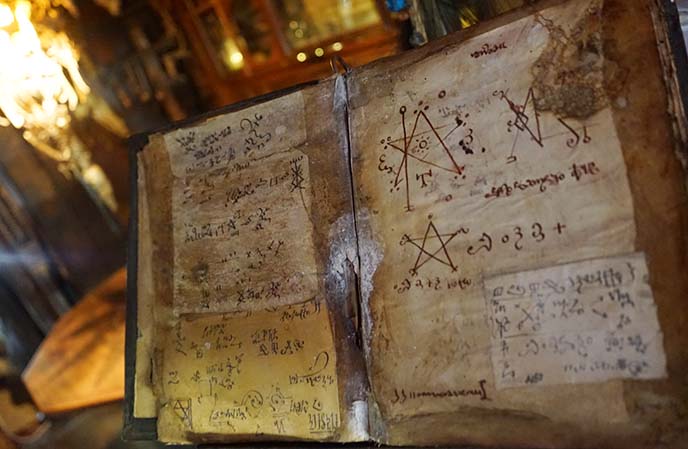
He writes in his guidebook (which everyone on the tour receives for free): “For hundreds, if not thousands, of years, The Temple, under the guardianship of the initiates, has been used as a place to celebrate the divine gift of love, to create spells, practice alchemy and summon angels and spirits from the other world.” The book of magic sits outside, beckoning you to decipher its spells.

Let your imagination soar at Viktor Wynd’s Museum of Curiosities and The Last Tuesday Society. Check out their site for special events, and I encourage you to come for a glass of absinthe and tour with Viktor for a delightfully bizarre experience.
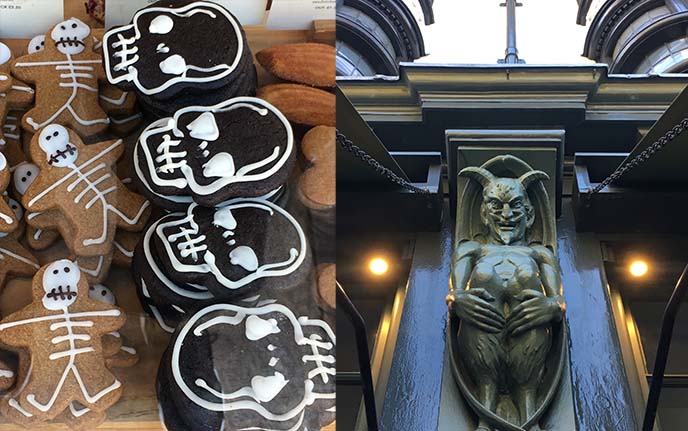
London turned out to be one hell of a destination for Halloween! There was plenty of spooky decor, food and attractions all around the city (I didn’t get to check out the London Dungeon or Jack the Ripper walking tour, but both were also recommended by local friends).
I leave you with some snaps from Chelsea. Skeleton and skull cookies from Gail’s Bakery, and a staring statue of Lucifer.
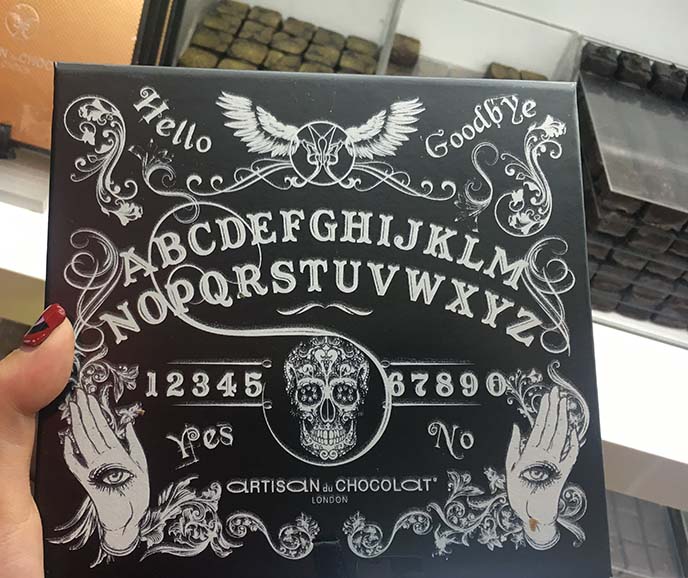
And how fabulous is this Ouija board box of chocolate, from Artisan du Chocolat? They also had pumpkin-shaped and flavored chocolates.
I still have another Gothic post from London to come, about Highgate Cemetery. And if you’re looking for Goth and alternative shopping, check out my Camden Market and Shoreditch guide.
Did you know that London had these dark attractions? If I missed out on anything, let me know in the comments and I’m sure I will be back in Britain soon.
SHARE & COMMENT
De Pijp, hip neighborhood of Amsterdam. Halloween travels & speaking at Experience Bucharest tourism conference!
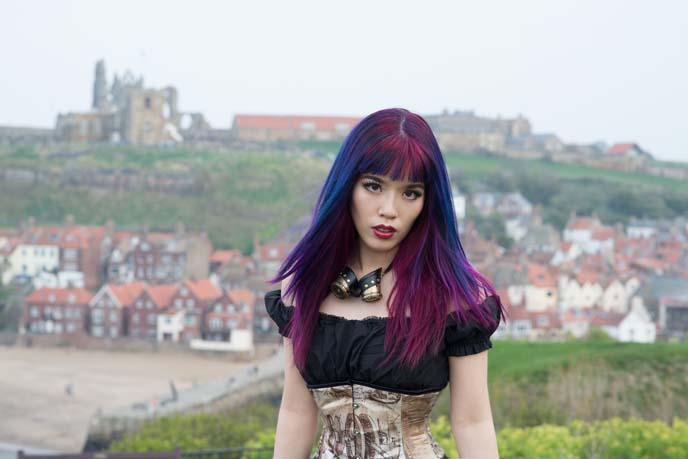
Get your fangs out… Halloween 2017 is going to be bloody fabulous!
This year, I’ll be in three European countries famous for Vampires, Alien, and Jack the Ripper. (Any guesses? The reveal is below.)
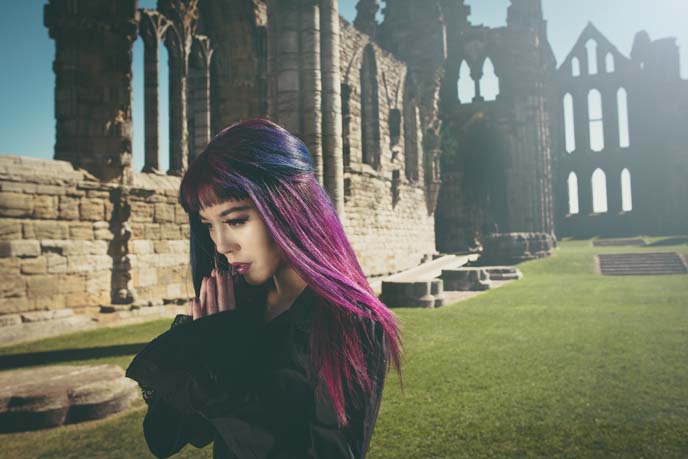
First, I’m excited to officially announce: I’m off to the land of vampires, Transylvania! I was invited to attend and speak at Experience Bucharest, the largest project ever to promote tourism in Romania’s capital and beyond. For several days, worldwide travel influencers will be gathering to see the capital through the eyes of its passionate residents.
It’s been my long-time dream to visit the ultimate Goth destination, and experience the dark underground culture. I’m honored to be speaking on at Travel Massive’s “Future of Tourism in Romania” conference, on a panel about travel and social media.
Follow along my social media @LaCarmina and hashtag #experiencebucharest to join the fun, including a visit to the castle of Count Dracula. (Above, photographer Joey Wong captured me in front of UK’s Whitby Abbey, an inspiration for Bram Stoker’s novel.)

While in Europe, I’m also teaming up with Switzerland Tourism and La Gruyère Tourisme… to visit the H.R. Giger bar in Gruyeres!
Fans of the Alien movies will immediately recognize these eerie bio-mechanical works, which form the backbone of the art design in the series. I’m fascinated with Giger’s imagination, and can’t wait to see his sci-fi bar and museum. (Images above by Kristin Thorogood Photography).

Finally… I’ll be in London, England for the first time in ages! Time to reunite with spooky friends, and check out the many dark Halloween events in the city. If you have suggestions for what to see and do (around the end of October), please let me know in the comments.
(To get you in the mood, here is my friend John’s London Goth travel guide. His photo above shows a store in Camden Market.)

Since I’m off to Europe again, I thought it was nigh time to release my final article about the Netherlands.
A while back, I shared my tour of Noord, the artistic district north of Centraal Station. Now, I’ll take you around De Pijp, another Amsterdam hipster neighborhood.
De Pijp translates to “the pipe,” for reasons that are unclear (perhaps it refers to the winding streets, or a former gas company with that name). In line with this spirit, the borough has a funky, good-humored vibe. Both travellers and locals come here for the bustling Albert Cuyp market, and to dine in ethnic restaurants.
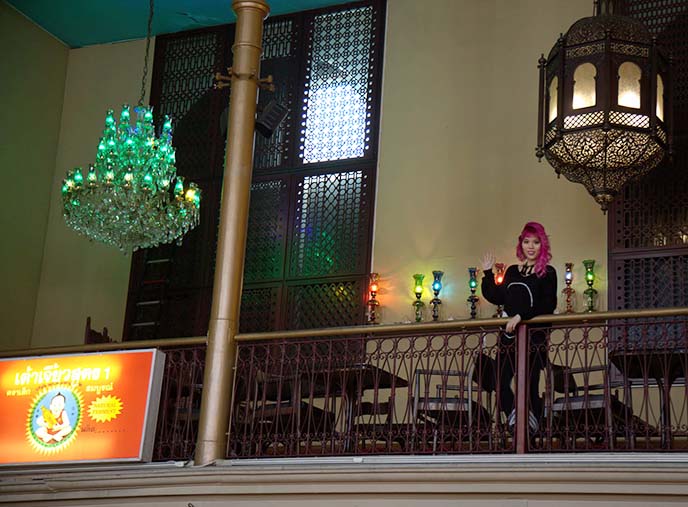
My friends and I went for lunch at Bazar Restaurant, which was recommended by several people. The word “bazaar” aptly describes the tw0-level space filled with Middle Eastern decor and music to delight the senses. When I walked in, I was transported back to the time I visited the markets of Morocco.
(Address: Albert Cuypstraat 182, 1073 Amsterdam, Netherlands)

The bathroom situation is straight out of 1001 Arabian Nights! Photographer Arina Dresviannikova had fun taking photos of Leyla (Dutch fashion / mommy blogger) and me, reflected in the many mirrors.
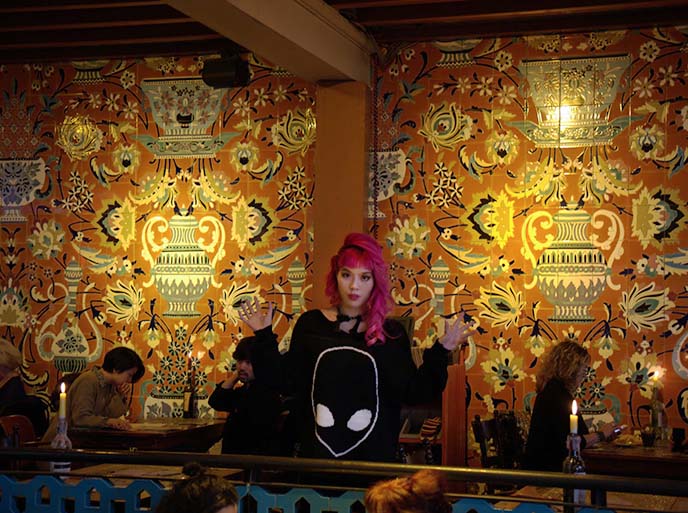
– I love my alien sweater, which looks similar to the keyboard emoji. There’s a similar alien shirt here, and more sci-fi fashion below:
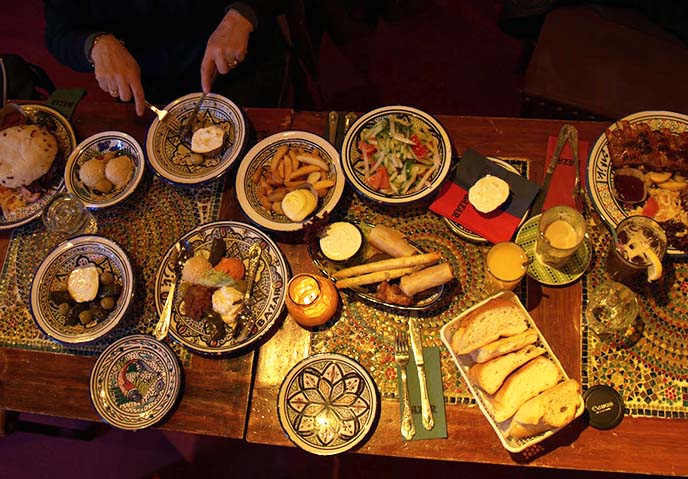
I began with a cup of fresh Moroccan mint tea, while Leyla perused the gluten free menu. Bazar has options for everyone, including vegan and vegetarian plates.
As you can see, we ordered a bit of everything! Bazar’s dishes take inspiration from the cuisine of North Africa and the Middle East — everything is moderately priced, and perfect for sharing with a group. I particularly loved the grape leaves, garlic sauce and falafel that came in one of the mixed platters.

A visit to Bazar feels like stepping into a Far Eastern fairy tale. I lounged under the high ceilings, next to these spectacular hand-painted tiled walls.
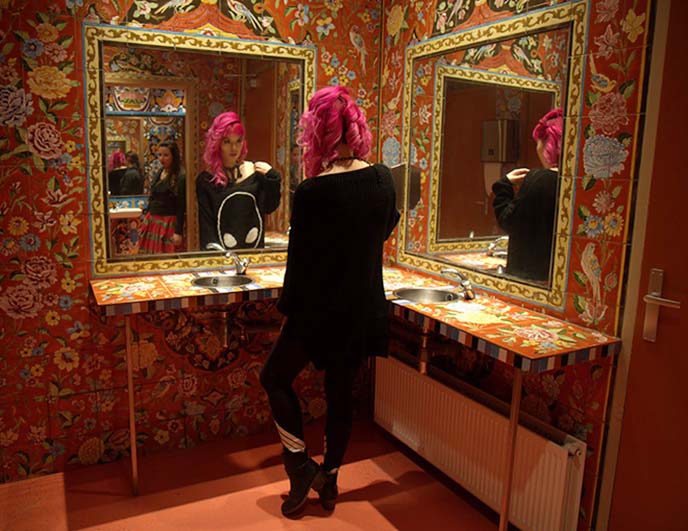
The vibrant spirit continues right outside Bazaar, at Albert Cuypmarkt. Six days a week, this street is packed with vendors selling everything from hippie skirts to stroopwafels.

I think we fit in rather well with the creative spirit of De Pijp! (My alien top is similar to this one; browse more styles below:)
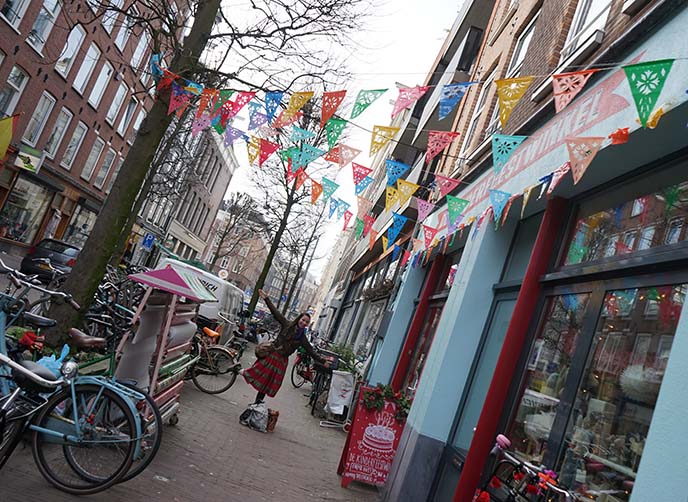
De Pijp was once a working class quarter, and home to residents of many nationalities. Today, the neighborhood remains filled with color. Leyla spreads her wings on Gerard Doustraat, a street lined with indie shops.

These rainbow flags beckoned us into De Kinderfeestwinkel, a store for kid’s party goods.

Doesn’t this feel like a Wes Anderson dreamscape? Masks and gadgets and hats everywhere!

Arina couldn’t resist taking home this magical stuffed unicorn. My attention went to the rack of Miffy books, of course.

The smiling ghost light stole my heart. We wandered past a 3D printing shop, and saw these “octo-pussycat” designs.
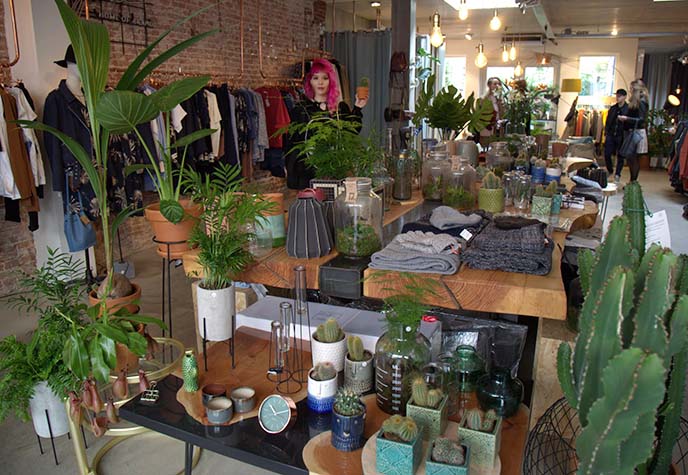
The other “hipster district,” Noord, is more for experimental art and murals. If you’re looking for indie fashion and cafes, De Pijp is the place to be.

Case in point: Anna + Nina, a shop with eclectic jewellery and old-world home accessories that reflect their love of travel.

The boutique is filled with textures: a floral silk dressing gown, golden leaves, fresh blossoms.

If I had more space in my apartment, I’d set up a curving mid-century modern floor lamp like this one. Many of the stores in De Pijp sell both clothing and interior decor, mostly by local designers.

Pick up a cactus, or Michael Jackson’s glittery mask… that’s the humorous spirit of De Pijp!

In the evening, my friends and I had dinner at Supperclub. The restaurant is designed like a nightclub, with flamboyant light projections and quirky performances throughout the evening.

All of the diners get to lounge on beds while eating dinner! Between the courses of the set menu, we watched dance and art performances right in front of us. My favorite was a woman with a giant eyeball for a head — she came up to each bed and interacted with guests, in funny ways.
(Watch Leyla’s travel vlog about Supperclub for footage of this unique dining experience. All our Amsterdam videos are in this playlist that she created on her LeylaFashion YouTube.)

Later in the evening, the venue turned into a dance club. Cheers to the fantastic staff, for keeping our wine-glasses filled and making this night a delight.

I leave you with some snaps from our walks around Amsterdam. I was drawn to the city’s modern architecture, and never-ending rows of bikes.

Amsterdam is great for wandering around and popping into stores. Arina is peering into Nunc, which carries handmade, fair-trade and recycled products.

We saw cute skeleton cats and robots in one window…

… and posse of Miffies in another. (Psst: I wrote this guide to Miffy stores in Amsterdam, which includes De Winkel Van Nijntje, Mr. Maria studio and a chocolaterie).

We couldn’t leave without a stroll through the Red Light district, home to brothels and marijuana cafes. Note: it’s forbidden to take photos of the girls in the glass windows. If you attempt to take an image, you’ll get shooed off by their security.

Tourists can see live erotic entertainment at venues like Casa Rosso, which has a cheeky red elephant mascot.

Dank je to Hotel The Exchange and Lloyd for hosting us, and to iAmsterdam for the City Card (which provides unlimited public transportation, and access to the top museums).
If you’re planning a visit to Amsterdam, here are all my Netherlands offbeat travel tips on a single page. I hope you find them helpful.

I had such a great time with my friends in Amsterdam, and I’m sure we will be back soon.
And now, time to prepare for London, Bucharest and Gruyeres! If you have travel advice for me, or know of events happening in these cities at the end of October, please let me know in the comments. Here’s to the bloodiest Halloween yet.


 LA CARMINA
LA CARMINA






